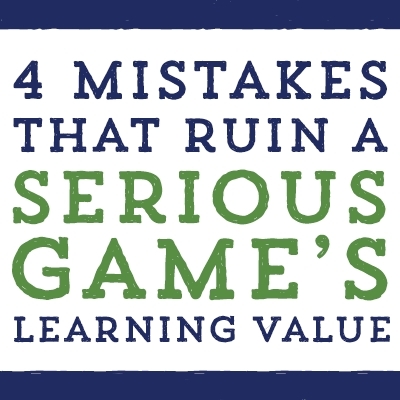2014 will be the year that many instructional designers are tasked with creating their first serious game. The research and case studies that support the use of games for learning are adding up… and we are beginning to see theory move into practice.As exciting as it is to see serious games taken, well, seriously, the heightened attention this learning method is receiving also brings a new set of challenges. As it turns out, most instructional designers were NOT trained in the field of game design. Also, most organizations do not have an “immersive serious game” fund sitting untouched, waiting to invest in a game-based learning solution.And while most L&D professionals are aware of the potential benefits serious games can provide to learners (and to their organizations), they are also aware that a poorly designed activity just won’t cut it. As it turns out, slapping points and badges on an eLearning course or cloning “Jeopardy” does not equate to a meaningful game.If you want to make serious games viable in your organization, you must combine a deep understanding of the ways games create a feeling of “fun” for players with a working knowledge of the essential elements required for learning. Without these tools, a serious game is doomed to fail.
What Does a Failed Serious Game Look Like?
But what does a “failed” serious game look like? How will you know if the game you have designed is missing the mark? A serious game with any of the four problems below needs some rework:
- Your serious game doesn’t motivate learners to keep playing and learningIf your game is overly simple or too easy to win, learners will quit before they’ve gained anything valuable from the experience. Use a combination of aesthetics, story, rewards and achievements, conflict, and other game elements to make the experience fun.
- Your serious game doesn’t allow learners to practice the cognitive task they need on the jobIf you’re creating an immersive simulation for a customer support team, you should have them practice collaboration… not compete with each other. If your game involves rote Q&A on company policies and procedures for new hires, avoid adding elements like a time limit. Doing so might make it harder to answer the questions, but it does not mirror the way the information must be recalled in real life. If a game element does not mirror the setting on the job, it should not be used.
- Your serious game doesn’t provide learners with feedback on their performanceIf you’re asking a series of questions as part of your game but not providing feedback when an answer is incorrect, you’re doing something wrong. Likewise, building a game without levels or stages will leave learners feeling aimless and unsure if they are succeeding.
- Your serious game does not support the acquisition of long-term memoriesIf the goal of your game is for players to remember information long after they’ve played, make sure you’ve incorporated learning principles like repetition and spaced learning to make the learning easier.
Make Your Serious Game Meaningful
Your serious game will only be successful if you link the “fun” in games to the essential elements needed for learning. Taking some time to learn the Serious Games' basics before designing a serious game can save time and effort later in the process.

